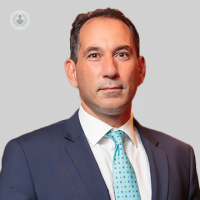Neuroendocrine tumours: what is the survival rate?
Written by:Neuroendocrine tumours (NETs) develop from cells of the neuroendocrine system and commonly occur in the intestine, but can also be found in the pancreas, lungs and throughout other organs in the body. Symptoms of NETs can differ and depend on whereabouts they are located. We spoke to leading consultant gastroenterologist Dr Christos Toumpanakis about NETs, how they are treated and the survival rate following a diagnosis.

What are NETs and where might they form?
NETs represent a rather uncommon, but complex groups of neoplasms. They consist of neuroendocrine cells which can be found in many places in the human body. Those cells can form “glands” such as “pituitary gland” or “adrenal glands”, or they can be diffusely distributed in many organs, mainly the gastrointestinal tract, pancreas and lungs.
For that reason, NETs are mainly located in our digestive system and lungs. Those “neuroendocrine cells” can secrete specific hormones and consequently, quite a few NETs are producing hormonal-related symptoms, such as facial “flushing’’, chronic diarrhoea, episodes of fasting hypoglycemia (low blood sugar), resistant to treatment, stomach or duodenal ulcers etc.
In the past, NETs were considered a “rare” type of cancer. However, new data show that their annual incidence has substantially increased over the last 30 years, to seven new patients per 100,000 population per year in the UK.
How are NETs diagnosed?
NETs are usually slow-growing malignancies and they are diagnosed late, especially if patients do not develop any hormonal symptoms and present with vague symptoms. In the latter scenario, doctors may not suspect the presence of a NET.
NETs diagnosis is based on:
- The patient's symptoms (especially the hormonal-related ones).
- Raised levels of specific tumour markers in patients’ blood and urine.
- The demonstration of tumour lesions in scans (CT/MRI or nuclear medicine scans).
- Biopsy of one of the tumour lesions, which can confirm the diagnosis.
How are NETs treated?
Luckily, we have plenty of options to treat a patient with NET. The main goals of treatment are:
- To improve patients’ hormonal symptoms, which we can achieve, for example, with the administration of monthly injections (somatostatin analogues) that suppress hormonal secretion by the tumour.
- To resect the primary tumour lesion and if possible, the tumour metastases (tumour spread to other organs, such as liver). Those operations should be performed in specialist centres by expert surgeons.
- To prevent, for as long as possible, further spread of the tumour by choosing the most appropriate treatment from a variety of options. These include radioisotopes, which are administered intravenously and target the tumour lesions, oral medications, which inhibit tumour growth by stopping its ability to produce more vessels, and also chemotherapy.
Which factors determine the outcome of treatment?
The outcome of NET treatment depends on factors related to the tumour, such as the tumour load and its proliferation rate, and also factors related to the patient such as age, performance status and co-morbidities.
For those reasons and also taking into account the complexity of NETs, it is important that the choice of treatment is individualised. Decisions are made and in multi-disciplinary tumour board meetings, which are based in specialist centres.
What is the survival rate of NETs?
The median overall survival (OS) time for all patients has been 9.3 years (112 months). Localized NETs (without any spread), which had been successfully resected, had better median OS (>30 years).
Survival is less in patients in whom tumours had spread. Apart from the presence of metastatic spread, patients’ survival depends also on the primary tumour location and tumour proliferation rate.
Can some people live beyond five years?
In general, even in the presence of hepatic metastases (tumour spread in the liver), the five-year survival rate can be approximately 65%, nowadays, especially if patients are referred and treated in specialist NET centres. Therefore, patients can live beyond five years.
Additionally, in our unit, we have some patients who are still alive, more than 10 years after diagnosis, despite them having multiple hepatic metastases.
Dr Toumpanakis specialises in treating neuroendocrine tumours. If you would like his expert opinion in your case, you can book an appointment with him via his Top Doctor’s profile here. Can’t make it in person? He is also available for a video call using our e-Consultation tool, which is found on his profile too!


